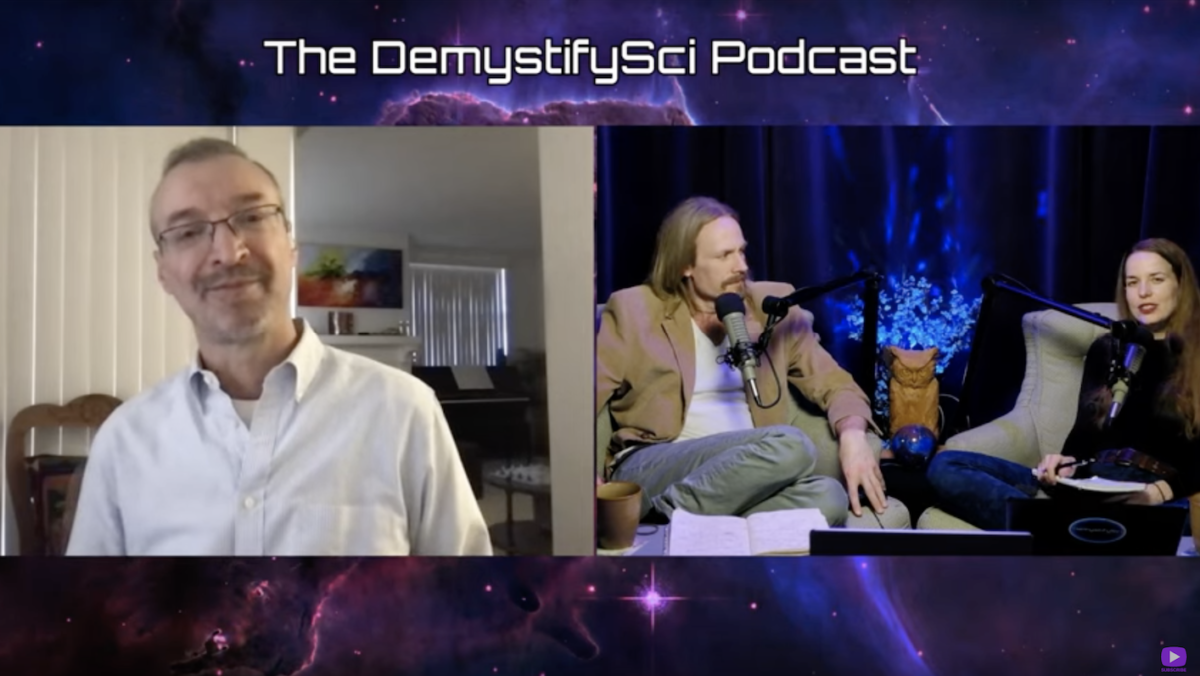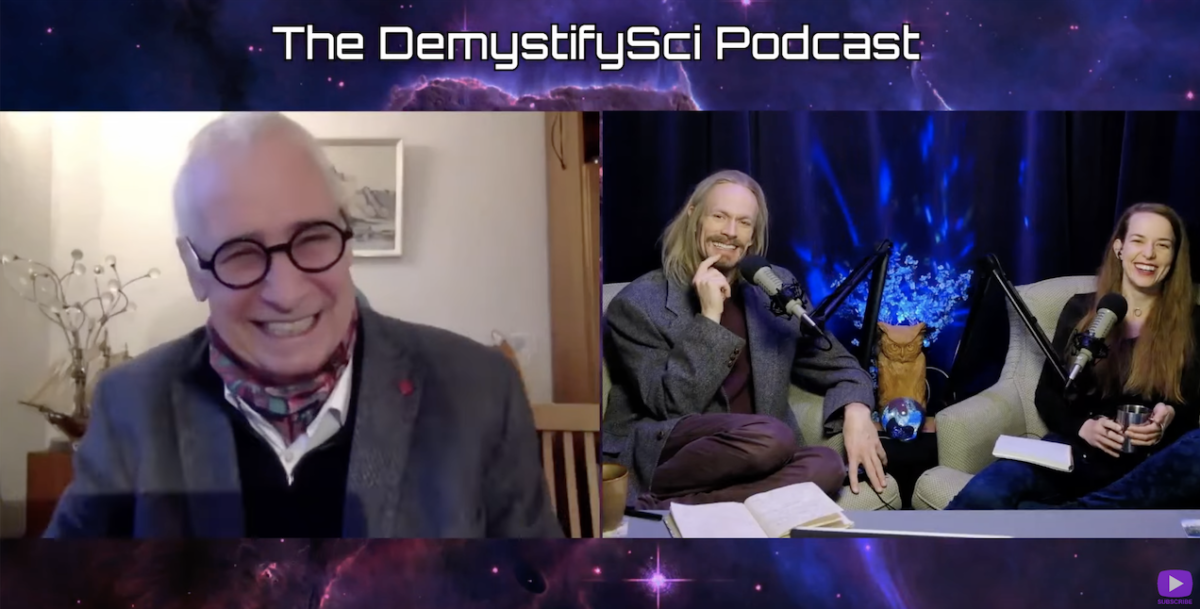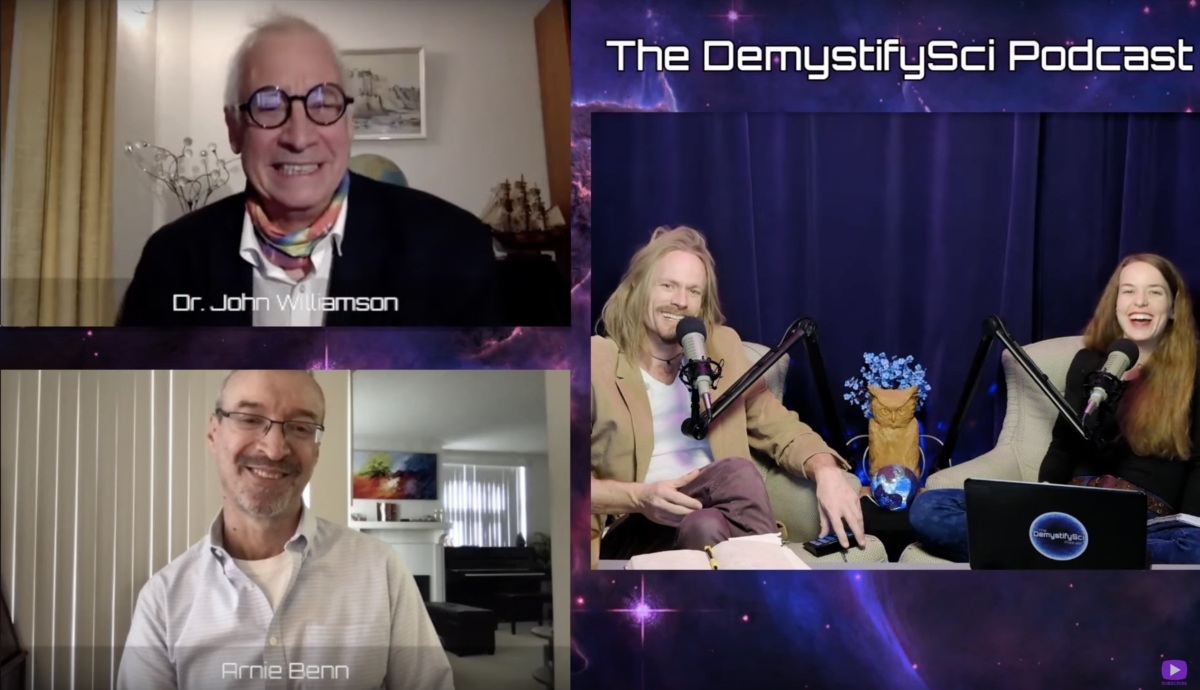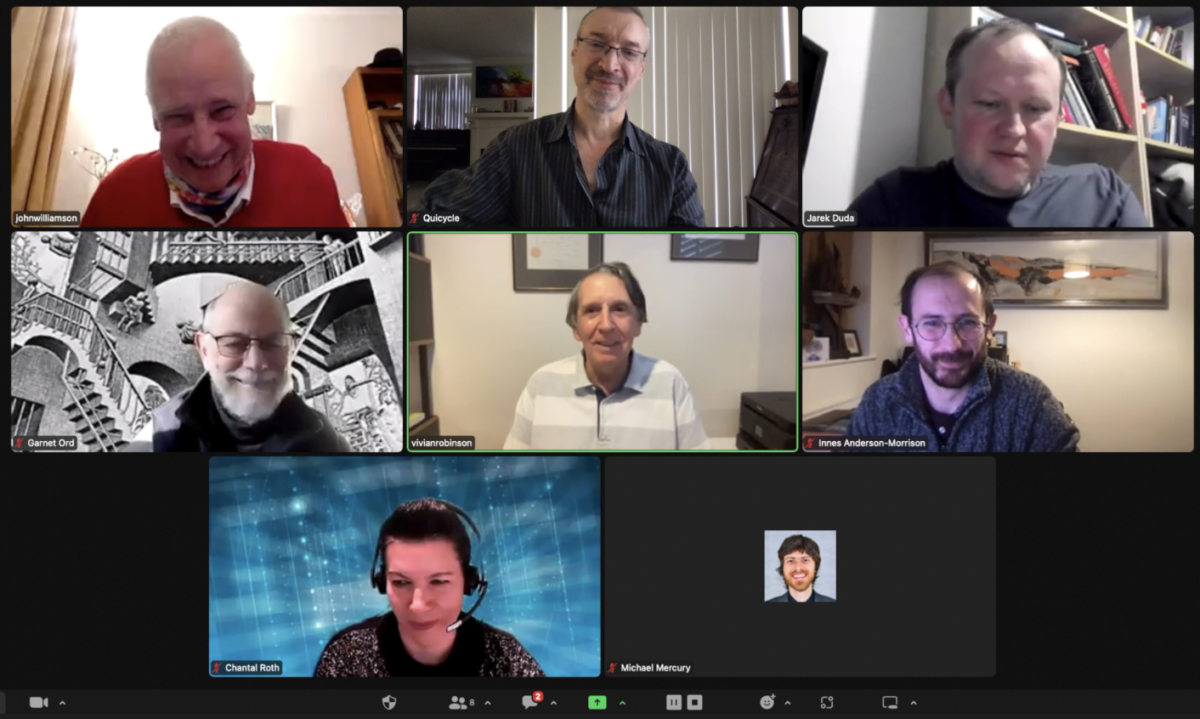
Dr. Vivian Robinson discusses the physics and physical mechanisms behind relativistic quantum mechanics, as well as where Einstein’s work has been misunderstood. Robinson explains not only where this misunderstanding arises within General Relativity, but also what the exact solution to Einstein’s equation in.
Recorded 9/30/23

Dr. John G. Williamson is a founding member of the Quicycle Society, and is back for a third conversation – this time about cosmological, electrical, and institutional questions. He is a veteran of CERN and the R&D division of Philips research who spends his days thinking about the unanswered problems in physics. In his view, there are foundational problems with key physical theories that scientists ignore at their own peril. Solutions to these inconsistencies will not be found at the end of a massively complicated equation that no one really understands – they will be found in the intuitive exploration of natural phenomena. We discuss the nature of the electron, possible causes for red shift, an explanation for charge, and the future of science. there are problems in physics that we can’t keep ignoring.

Dr. John G. Williamson is a well-known researcher and author whose work on particle physics, nano electronics, and on the physical foundations of atomic phenomena has been cited nearly 14,000 times. During his time at the advanced theoretical and experimental group at Philips Research, Williamson was part of the project that designed the first solid-state single electron device, and was able to take measurements of electrons in the quantum state. and discovered that they were enormous; in certain conditions, they were tens of nanometers across. This discovery, combined with his skepticism over particle physics that he acquired during his time at CERN, set him off on a new quest: to be the first person to truly understand the nature of the electron. With his Philips colleague Martin van der Mark, Williamson started the Quantum Bi-Cycle Society, which explores the physical foundation for atomic phenomena and hopes to settle, once and for all, the mysterious nature of the atom. We talk to him about the architectural principles necessary to satisfy the equations of quantum mechanics, serious problems with the quark model, the relationship between spin and charge, and why the definition of time is not the same thing as the nature of time.

Arnie Benn’s recent work has been focused on the behavior of humans and magnets. In his upcoming book, The Animal In The Mirror, he explores the evolutionary patterns still at play in the human mind, with an emphasis on the biological aspects that tend to govern cognitive processes. For the Quantum Bicycle Society, he has been exploring material explanations for magnetism as a function of atomic orbitals shape. We talk about music, the endless project of maintaining the landscape of the soul, cosmological mysteries, and material explanations for atomic phenomena.

Dr. John G. Williamson is a guest on the Demystify Science Podcast.
He is a well-known researcher and author whose work on particle physics, nano electronics, and on the physical foundations of atomic phenomena has been cited nearly 14,000 times. During his time at the advanced theoretical and experimental group at Philips Research, Williamson was part of the project that designed the first solid-state single electron device, and was able to take measurements of electrons in the quantum state. and discovered that they were enormous; in certain conditions, they were tens of nanometers across. This discovery, combined with his skepticism over particle physics that he acquired during his time at CERN, set him off on a new quest: to be the first person to truly understand the nature of the electron. With his Philips colleague Martin van der Mark, Williamson started the Quantum Bi-Cycle Society, which explores the physical foundation for atomic phenomena and hopes to settle, once and for all, the mysterious nature of the atom. We talk to him about the architectural principles necessary to satisfy the equations of quantum mechanics, serious problems with the quark model, the relationship between spin and charge, and why the definition of time is not the same thing as the nature of time.
PODCAST INFO:
Check our short-films channel, @DemystifySci:  / demystifyingscience AND our material science investigations of atomics, @MaterialAtomics
/ demystifyingscience AND our material science investigations of atomics, @MaterialAtomics  / @materialatomics Join our mailing list https://bit.ly/3v3kz2S PODCAST INFO: Anastasia completed her PhD studying bioelectricity at Columbia University. When not talking to brilliant people or making movies, she spends her time painting, reading, and guiding backcountry excursions. Michael Shilo also did his PhD at Columbia studying the elastic properties of molecular water. When he’s not in the film studio, he’s exploring sound in music. They are both freelance professors at various universities. – Blog: http://DemystifySci.com/blog – RSS: https://anchor.fm/s/2be66934/podcast/rss – Donate: https://bit.ly/3wkPqaD – Swag: https://bit.ly/2PXdC2y
/ @materialatomics Join our mailing list https://bit.ly/3v3kz2S PODCAST INFO: Anastasia completed her PhD studying bioelectricity at Columbia University. When not talking to brilliant people or making movies, she spends her time painting, reading, and guiding backcountry excursions. Michael Shilo also did his PhD at Columbia studying the elastic properties of molecular water. When he’s not in the film studio, he’s exploring sound in music. They are both freelance professors at various universities. – Blog: http://DemystifySci.com/blog – RSS: https://anchor.fm/s/2be66934/podcast/rss – Donate: https://bit.ly/3wkPqaD – Swag: https://bit.ly/2PXdC2y

Q&A following Vivian Robinson’s presentation on Universal Particle Structure.
In the presentation, Dr. Vivian Robinson summarized his approach to subatomic particles, based upon the rotating photon model of matter. It unifies electromagnetism with the fundamental structure of matter particles, Einstein’s special relativity corrections, the de Broglie wavelength, the origin of charge, elementary particles, the strong nuclear force and nuclear structure, atoms, and the origin of some of their chemical properties. It uses only three space dimensions and one time dimension.
This talk was given to the “Models Of Particles” Group, moderated by Jarek Duda, on 03/11/23

In this presentation, Dr. Vivian Robinson summarizes his approach to subatomic particles, based upon the rotating photon model of matter. It unifies electromagnetism with the fundamental structure of matter particles, Einstein’s special relativity corrections, the de Broglie wavelength, the origin of charge, elementary particles, the strong nuclear force and nuclear structure, atoms, and the origin of some of their chemical properties. It uses only three space dimensions and one time dimension.
Presented to the Models of Particles group on 03/11/23.

What The Universe Is Made Of — John G. Williamson and Arnie Benn, Quantum Bicycle Society
Dr. John G. Williamson and Arnie Benn are core members of the Quantum Bicycle Society, a collaborative group scientists who aims to build better models for everything from quantum mechanics to the cosmos. Williamson began the project with his colleague Dr. Martin van der Mark after a disillusioning stint at CERN, where he was confronted by the massive discrepancies between experimental results and the predictions of quantum chromodynamics. We talk the nature of the electron, the ur-stuff from which everything is made, misconceptions about the proton, alternative explanations for cosmic microwave background radiation, and more.
Support the scientific revolution by joining the DemystifySci Patreon: https://bit.ly/3lcAasB

This is the Q&A and discussion following the talk by Arnie Benn, featuring John G. Williamson, Vivian Robinson, Garnet Ord, Lyndon Ashmore, Innes Anderson-Morrison, Jarek Duda, and Chantal Roth.
Topics discussed include quantu mechanics, relativity, electron superposition, and the spin tri-vector potential.
The Physics of Sub-Quantum Spin: https://quicycle.com/video/qv0112-arnie-benn-the-physics-of-sub-quantum-spin/
Building upon the foundation of John Williamson’s Sub-Quantum Mechanics and Absolute Relativity Theory, the talk delved into the concept of quantum spin, identifying the 3 specific components of the electron’s internal spin. These components were then leveraged in order to clarify the topological difference between ‘spin-up’ and ‘spin-down’ electrons, the physical spin-mediated mechanisms underlying electron bonding, the Pauli Exclusion ‘Principle’ and Hund’s 2nd Rule, as well as deriving the magnetic field from the spin tri-vector potential. The physical, spin-mediated mechanism involved in matter-antimatter annihilation was also explored.
The talk was given to The Quantum Bicycle Society on 2/4/23

This presentation offers answers to the following questions about electrons, charge, quantization, and spin:
1. What is the sub-structure of the electron? 2. What is the origin of its monopole charge? 3. What are the precise components of electron quantum spin? 4. What is the topological difference between a spin-up electron and a spin-down electron? 5. By what mechanism do electrons pair so eagerly despite having like charges? 6. What physics causes electrons to pair with opposite spins by ‘Pauli Exclude’ with like spins? 7. What is the physics of Hund’s 2nd Rule favoring like-spin electron resonances in orbitals? 8. What might the mechanism of matter-antimatter annihilation be? 9. What mathematics encompasses this ‘Sub-Quantum Mechanics’?
Building upon the foundation of John Williamson’s Sub-Quantum Mechanics and Absolute Relativity Theory, this talk delves into the concept of quantum spin, identifying the 3 specific components of the electron’s internal spin. These components are then leveraged in order to clarify the topological difference between ‘spin-up’ and ‘spin-down’ electrons, the physical spin-mediated mechanisms underlying electron bonding, the Pauli Exclusion ‘Principle’ and Hund’s 2nd Rule, as well as deriving the magnetic field from the spin tri-vector potential. We also probe the physical, spin-mediated mechanism involved in matter-antimatter annihilation.
This talk was given to The Quantum Bicycle Society on 2/4/23










